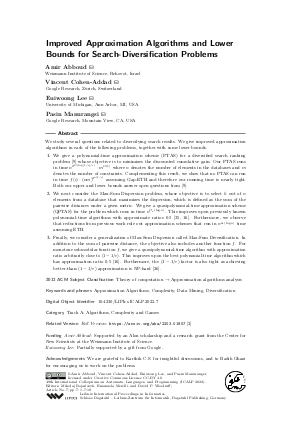@InProceedings{abboud_et_al:LIPIcs.ICALP.2022.7,
author = {Abboud, Amir and Cohen-Addad, Vincent and Lee, Euiwoong and Manurangsi, Pasin},
title = {{Improved Approximation Algorithms and Lower Bounds for Search-Diversification Problems}},
booktitle = {49th International Colloquium on Automata, Languages, and Programming (ICALP 2022)},
pages = {7:1--7:18},
series = {Leibniz International Proceedings in Informatics (LIPIcs)},
ISBN = {978-3-95977-235-8},
ISSN = {1868-8969},
year = {2022},
volume = {229},
editor = {Boja\'{n}czyk, Miko{\l}aj and Merelli, Emanuela and Woodruff, David P.},
publisher = {Schloss Dagstuhl -- Leibniz-Zentrum f{\"u}r Informatik},
address = {Dagstuhl, Germany},
URL = {https://drops.dagstuhl.de/entities/document/10.4230/LIPIcs.ICALP.2022.7},
URN = {urn:nbn:de:0030-drops-163481},
doi = {10.4230/LIPIcs.ICALP.2022.7},
annote = {Keywords: Approximation Algorithms, Complexity, Data Mining, Diversification}
}

 Creative Commons Attribution 4.0 International license
Creative Commons Attribution 4.0 International license






